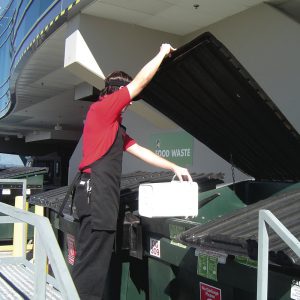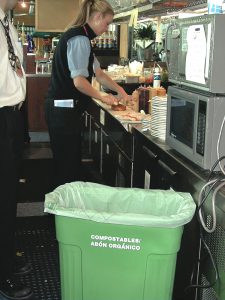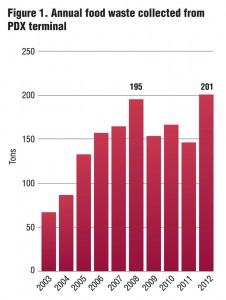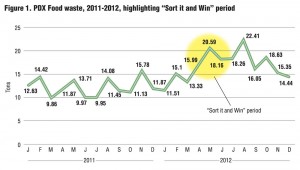After significant program tweaks, including an employee rewards program, the Portland, Oregon International Airport breaks its previous records for food waste diversion.
Maia Nativ
BioCycle April 2013, Vol. 54, No. 4, p. 31

PDX provides a central collection point for the food waste from the various restaurants. Diverted organics represent about 6 percent of materials recycled at the airport.
In 2012, the food waste program became a priority for the Port’s waste minimization team, resulting in a record-breaking year — 201 tons — surpassing the previous food collection record set in 2008 (a peak air travel year, preceding the economic downturn). Figure 1 shows year-to-year food waste tonnages diverted. How the food waste collection program was reinvigorated resulting in the record–setting year in 2012 is an interesting story.
Program History
Since 2003, the Port has partnered with Portland State University’s Community Environmental Services (CES), a student-based research and service organization that coordinates waste reduction and recycling projects throughout the region. The airport food waste collection program began in 2003 with restaurants in the public area (i.e., “front of the house”) of the airport terminal in anticipation of city-wide commercial organics collection that had not yet begun. Initially, only vegetative preconsumer food waste was allowed (meats, fats and dairy products were not accepted); materials were transported to a local composter. With introduction of a regional food waste collection program in April 2005, PDX food waste diversion was able to expand to all restaurants in the airport and the feedstock restrictions were lifted.
Air travel at PDX has increased from approximately 12.3 million passengers in 2003 to over 14 million travelers in 2012. There is a direct relationship between passenger flow, increases in concessions sales and increases in food waste generation. In 2003, the average concessions sales were roughly $2.2 million/month, whereas in 2012 monthly concessions sales reached as high as $4.3 million in a single month. There has been an increase in food and beverage services to meet the increased demand.
During the three years between 2009 and 2011, food waste collection struggled. In 2011, only 147 tons of food were collected, the lowest the program had seen since 2005. Although this lackluster performance was due, in part, to a weak economy and therefore lower than normal enplanement numbers and concessions sales, lack of management support and employee training and incentives also appeared to be factors. A 2010 evaluation of PDX terminal waste found that 57 percent of all landfill bound waste from concessions was made up of food and compostable materials.
Regaining Diversion Momentum
As the economy and air travel picked up again in 2011, it was met with a renewed focus on back of the house food waste collection. In late 2011 and early 2012, the Port developed a plan that ultimately resulted in a reinvigorated food waste program. The plan identified a number of barriers and challenges to food waste collection at PDX that needed to be addressed to increase collection rates. PDX provides a central waste collection point and pays the garbage bill for all airport uses including airlines and concessionaires; waste management costs are rolled into their lease or rental payment. Because they don’t see the direct cost increases and decreases associated with the wastes they produce, there is no financial incentive for restaurant managers to enforce food waste collection.
Rates paid by PDX for source separated food waste collection and composting are often cheaper than garbage rates, however concessionaires do not benefit from costs savings associated with increased food waste collection. The Port continues to assess options to incentivize waste generators at PDX to reduce the amount of waste they produce and increase landfill diversion rates. To date the Port has saved approximately $11,000 on disposal fees by diverting food waste and reducing landfill weights.
Restaurants also experience relatively high employee turnover resulting in a knowledge barrier about the waste system and the airport’s environmental goals. Concessions’ managers were not consistently delivering the “No Food Waste In the Garbage” message to employees and employee enthusiasm and investment in the airport’s food waste program were clearly lacking. Therefore, reaching out to and encouraging employees to change their behavior in the kitchens around food waste collection and the transport to the central collection containers became essential. The Port decided to create a rewards program as a way to encourage employee participation and support behavior change. An initially proposed rewards program involved observing employees sorting food waste and rewarding them with an entry for a substantial raffle prize, such as a plane ticket.
To better understand how to engage employees to effect permanent behavior change and increase enthusiasm, the Port teamed with Dr. Thomas Doherty, a local college professor specializing in ecopsychology and behavioral psychology. Doherty’s perspective on the psychology behind adopting sustainable practices caused the Port to reassess the proposed rewards program. He suggested providing instantaneous, positive feedback to individual employees at the time they are seen collecting or managing food waste properly as a much more effective way to permanently change behaviors. With this information, CES went back to the drawing board to redesign and reconfigure a rewards program consistent with Doherty’s insight.
The “Sort It and Win” program was a huge success and many lessons were learned along the way. For example, it also shifted how kitchen employees interacted with waste outreach staff — from authoritative and policing to a more peer-to-peer relationship based on trust, respect and encouragement. Employees became connected to the program and interested in food waste, which facilitated broader conversations about waste reduction. Improved relationships with employees also provided an opportunity to explain the additional work required to remove contamination from the central food waste bins and helped reduce contaminants in the food waste stream.

A 3-month pilot designed to encourage participation in the food waste program rewarded employees with a $5 gift card at the time they were seen collecting or managing food waste properly.
Five Year Zero Waste Plan
The Port is working toward a five-year Zero Waste plan and will set a target for all PDX departments and tenants to divert at least 90 percent of materials from the landfill. Currently, only 31 percent of the approximate 10 tons of waste generated daily by operations at the PDX terminal (concessions, public, airlines and numerous airport related support businesses and organizations) are currently diverted into recycling. Food waste represents approximately 6 percent of the recycled materials. Waste audits have revealed that a significant amount of food and compostable materials can still be diverted from the landfill waste. The Port plans to take steps towards capturing organic waste including continuing to focus on outreach and rewards programs, regularly communicating program goals and successes with stakeholders, including waste minimization language in airport rules, leases and agreements, and maintaining and building relationships with airport tenants and tenant managers who are setting goals for the future. The Port gets involved with new restaurant tenants early on, so they can incorporate food collection in their kitchen layout.
Future upgrades to food courts and the addition of restaurant concessions will create new opportunities to capture more compostables from the public area. The Port is also aware that much of the waste minimization focus to date has been aimed at recycling (composting food waste). In the future, more focus will be placed on reducing the amount of wasted food and diverting edible food to households struggling with hunger in the Portland metropolitan area. The Port recently implemented a food donation program, which continues to surpass expectations in its second month of operation.
Maia Nativ is the CES project lead for the Port of Portland Waste Minimization program. She is pursuing a Masters in Public Administration at Portland State University. Before coming to CES, Maia created and implemented composting and recycling programs while working as an AmeriCorps member at Portland Public Schools.












